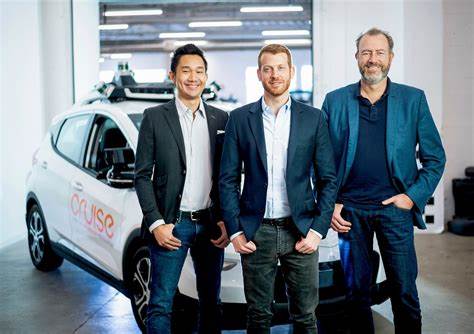Cruise, one of the leading companies in the race to develop autonomous vehicles, has announced that its CEO and co-founder Kyle Vogt has resigned from his position. The news comes after the company faced a major setback in October, when the California Department of Motor Vehicles (DMV) suspended its operating permit due to safety concerns.
Table of Contents
Cruise CEO: Kyle Vogt

Vogt, who co-founded Cruise in 2013 and sold it to General Motors (GM) in 2016 for more than $1 billion, announced his departure on the social media site X, formerly Twitter. He did not give a specific reason for his decision, but said he planned to spend more time with his family and explore some new ideas.
“Cruise is still just getting started, and I believe it has a great future ahead.”
Vogt said on X
He was named CEO in 2022 and formerly held that position from 2013 to 2019, according to his LinkedIn profile.
What led to Vogt’s resignation?
Vogt’s resignation comes at a turbulent time for Cruise, which has been testing its self-driving cars in San Francisco for several years. The company reportedly had about 400 cars operating in the city, with the goal of launching a robotaxi service for the public.
However, in October, the California DMV suspended the company’s operating permit, citing concerns about risks to public safety. The agency alleged that Cruise withheld video of a robotaxi dragging a person down a street in September, and that the company failed to report other incidents involving its vehicles.
The DMV also said that Cruise violated the terms of its permit by testing its cars without human safety drivers, and by allowing passengers who were not employees or contractors to ride in its vehicles.
In response, Cruise suspended its operations across all of its fleets and said it was working to strengthen public trust. The company also said it was cooperating with the DMV and other authorities to resolve the issues and resume its testing.
Who will lead Cruise now?
Following Vogt’s resignation, Cruise has appointed two presidents to lead the company. Mo Elshenawy, who is currently executive vice president of engineering at Cruise, will serve as president and chief technology officer. Craig Glidden, who is chief administrative officer at GM, will serve as president and continue in his current role.
In addition, Jon McNeill, who is a member of GM’s board of directors and Cruise’s board, has been appointed vice chairman of Cruise’s board.
A spokesperson for Cruise said the company had accepted Vogt’s resignation and thanked him for his contributions.
“Kyle has been instrumental in building Cruise from a startup to a leader in self-driving technology. We are grateful for his vision and leadership, and we wish him all the best in his future endeavors,”.
the spokesperson said
What are the implications of Vogt’s resignation?
Vogt’s resignation is a significant blow for Cruise, which has been one of the most ambitious and well-funded players in the self-driving-car industry. The company has raised more than $10 billion from investors, including GM, Honda, SoftBank, and Microsoft.
Cruise has also been one of the few companies to receive a permit from the California Public Utilities Commission (CPUC) to offer paid rides in its self-driving cars, although it has not yet launched the service.
However, Cruise has also faced fierce competition from other companies, such as Waymo, Tesla, Uber, and Lyft, which are also developing and testing their own autonomous vehicles. The suspension of its operating permit in California, which is a key market and testing ground for self-driving cars, has put Cruise at a disadvantage and raised questions about its safety record and practices.
Vogt’s resignation may also signal a change in the company’s culture and strategy, as it transitions from a startup to a more mature and regulated business. The new leadership team may have to balance the company’s innovation and growth goals with the expectations and interests of its parent company GM, its investors, and its regulators.

FAQ
Some trending questions and answers on the internet:
Who is the CEO and co-founder of Cruise?
Kyle Vogt is the CEO and co-founder of Cruise, a self-driving-car unit of General Motors. He announced his resignation on Sunday on the social media site X, formerly Twitter.
Why did Cruise lose its operating permit in California?
The California Department of Motor Vehicles suspended Cruise’s operating permit in October, citing concerns about risks to public safety. The agency alleged that Cruise withheld video of a robotaxi dragging a person down a street in San Francisco.
What is the status of Cruise’s operations?
Cruise suspended operations across all of its fleets in October and said it was working to strengthen public trust. The company has not announced when it will resume testing its autonomous cars in California or other states.
Who will replace Kyle Vogt as Cruise’s leader?
Mo Elshenawy, who is currently executive vice president of engineering at Cruise, will serve as president and chief technology officer for Cruise. Craig Glidden will serve as president and continue as chief administrative officer. Jon McNeill, who is a member of GM’s board of directors and Cruise’s board, has been appointed vice chairman of Cruise’s board.
Conclusion
Cruise, a self-driving-car company owned by GM, faces a leadership shake-up after its CEO and co-founder Kyle Vogt steps down following the suspension of its operating permit in California. The company has appointed two presidents to lead the company and has suspended its operations to address the safety concerns raised by the DMV. Vogt’s resignation is a major setback for Cruise, which has been one of the leading and most well-funded players in the self-driving-car industry, but has also faced fierce competition and regulatory challenges.
If you enjoyed this article, please visit our blog USA Trend for more breaking news and insights on technology, entertainment, and politics. You can also follow us on X and Instagram for updates and exclusive content. Thank you for reading!